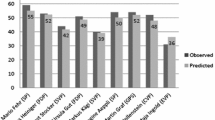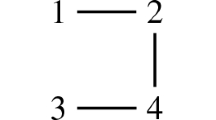Abstract
We provide exact relations giving the probability of individual and coalitional manipulation of three specific social choice functions (Borda rule, Copeland rule, Plurality rule) in three-alternative elections when the notion of self-selectivity is imposed. We use each type of tie-breaking rule in the case of three-candidate election in order to make the results more robust. Analyzing our probabilities, we can point out that the probability of individual and coalitional manipulation tend to vanish significantly when the notion of self-selectivity is imposed.


Similar content being viewed by others
References
Aleskerov, F., & Kurbanov, E. (1999). degree of manipulability of social choice procedures. In Alkan, et al. (Eds.), Current trends in economics (pp. 13–28). Berlin Heidelberg New York: Springer.
Barberà, S., & Beviá, S. (2002). Self-selection consistent functions. Journal of Economic Theory, 105, 263–277.
Barberà, S., & Jackson, M. O. (2004). Choosing how to choose: Self-stable majority rules and constitutions. The Quarterly Journal of Economics, 119(3), 1011–1048.
Diss, M., Louichi, A., Merlin, V., & Smaoui, H. (2012). An example of probability computations under the IAC assumption: The stability of scoring rules. Mathematical Social Sciences, 64(1), 57–66.
Diss, M., & Merlin, V. (2010). On the stability of a triplet of scoring rules. Theory and Decision, 69, 289–316.
Ehrhart, E. (1962). Sur les polyèdres rationnels homothétiques à n dimensions. Comptes rendus de l’Académie des sciences Paris, 254, 616–618.
Ehrhart, E. (1967). Sur un problème de géométrie diophantienne linéaire. Ph.D. thesis, J R A Math, vol. 226, pp. 1–49 .
Favardin, P., & Lepelley, D. (2006). Some further results on the manipulability of social choice rules. Social Choice and Welfare, 26, 485–509.
Favardin, P., Lepelley, D., & Serais, J. (2002). Borda rule, Copeland method and strategic manipulation. Review of Economic Design, 7, 213–228.
Gehrlein, W. V., & Fishburn, P. C. (1976). Condorcet’s paradox and anonymous preference profiles. Public Choice, 26, 1–18.
Gehrlein, W. V., & Lepelley, D. (2003). On some limitations of the median voting rule. Public Choice, 117, 177–190.
Gibbard, A. F. (1973). Manipulation of voting schemes: A general result. Econometrica, 41, 587–601.
Guilbaud, G. T. (1952). Les théories de l’intérêt général et le problème logique de l’agrégation. Economie Appliquée, 5, 501–584.
Houy, N. (2003). Dynamics of stable sets of constitutions. Mimeo.
Houy, N. (2004). A note on the impossibility of a set of constitutions stable at different levels. Mimeo.
Houy, N. (2005). De la stabilité des procédures et constitutions en théorie du choix social. Ph.D. Thesis, Paris 1.
Kelly, J. (1988). Minimal manipulability and local strategy-proofness. Social Choice and Welfare, 5, 81–85.
Kelly, J. (1993). Almost all social choice rules are highly manipulable, but few aren’t. Social Choice and Welfare, 10, 161–175.
Koray, S. (2000). Self-selective social choice functions verify Arrow and Gibbard–Satterthwaite theorems. Econometrica, 68(4), 981–995.
Koray, S., & Unel, B. (2003). Charactrization of self-selective social choice functions on the tops-only domain. Social Choice and Welfare, 20, 495–507.
Laslier, J.-F. (2010). In silico voting experiments. In J.-F. Laslier & R. Sanver (Eds.), Handbook of approval voting (pp. 311–335). Heidelberg: Springer.
Lepelley, D., Louichi, A., & Smaoui, H. (2008). On Ehrhart polynomials and probability calculations in voting theory. Social Choice and Welfare, 30, 363–383.
Lepelley, D., & Mbih, B. (1987). The proportion of coalitionally unstable situations under the plurality rule. Economics Letters, 24, 311–315.
Lepelley, D., & Mbih, B. (1994). The vulnerability of four social choice rules to coalitional manipulation of preferences. Social Choice and Welfare, 11, 253–265.
Lepelley, D., & Mbih, B. (1996). Strategic manipulation in committees using the plurality rule: Alternative concepts and frequency calculations. Group Decision and Negotiation, 6, 119–138.
Lepelley, D., & Valognes, F. (2003). Voting rules, manipulability and social homogeneity. Public Choice, 116, 165–184.
Maus, S., Peters, H., & Storcken, T. (2007). Minimal manipulability: Anonymity and unanimity. Social Choice and Welfare, 29, 247–269.
Nitzan, S. (1985). The vulnerability of point-voting schemes to preference variation and strategic manipulation. Public Choice, 47, 349–370.
Satterthwaite, M. A. (1975). Strategyproofness and Arrow’s conditions: Existence and correspondences for voting procedures and social welfare functions. Journal of Economic Theory, 10, 187–217.
Serais, J. Sensivity to strategic candidacy by exiting for scoring rules and Copeland. University of Caen Basse-Normandie, unpublished paper.
Smith, D. (1999). Manipulability measures of common social choice functions. Social Choice and Welfare, 16, 639–661.
Verdoolaege, S., Seghir, R., Beyls, K., Loechner, V., & Bruynooghe, M. (2004). Analytical computation of Ehrhart polynomials: Enabling more compiler analysis and optimizations. In Proceedings of international conference on compilers, architecture, and synthesis for embedded systems. Washington DC, pp. 248–258.
Wilson, M. C., & Pritchard, G. (2007). Probability calculations under the IAC hypothesis. Mathematical Social Sciences, 54, 244–256.
Acknowledgments
I am indebted to Richard Baron, Gérald Chatagnon, Ahmad Fliti and two anonymous referees of this journal for helpful comments on an earlier version of this paper.
Author information
Authors and Affiliations
Corresponding author
Rights and permissions
About this article
Cite this article
Diss, M. Strategic manipulability of self-selective social choice rules. Ann Oper Res 229, 347–376 (2015). https://doi.org/10.1007/s10479-014-1763-7
Published:
Issue Date:
DOI: https://doi.org/10.1007/s10479-014-1763-7




